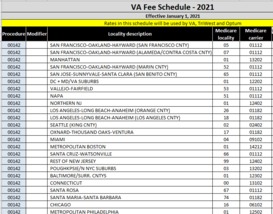|

 Are you a community provider who has gone above and beyond to provide care to Veterans through the VA’s Community Care Network (CCN)? You might be eligible for a quality designation!
More and more eligible Veterans are seeking community care, and choosing a provider from the growing list in VA’s Community Care Network (CCN) can be a challenge. That’s why VA, along with its CCN partners, developed the HPP designation. HPP status helps guide Veterans when it comes to their healthcare needs. To be designated as an HPP, community providers are evaluated by nationally recognized quality and cost-efficiency measures such as Healthcare Effectiveness Data and Information Set (HEDIS) and Physician Quality Reporting System (PQRS).
“We developed the HPP designation to recognize providers who are committed to ensuring Veterans receive the highest quality and timely care,” said Dr. Clinton Greenstone, Executive Director of Clinical Integration and Field Operations, VHA Office of Community Care. "Providers dedicate their time and services to Veterans and as part of our Community Care Network, they should be acknowledged, and Veterans need to see and understand the importance of this designation.”
As of December 2020, nearly 20 percent of VHA’s community providers are designated as HPPs.
The three different types of HPP designations used are Yes, No, or Unknown:
- Y (Yes): The provider meets the CCN HPP designation based on the quality and cost-efficient care criteria.
- N (No): The provider does not meet the CCN HPP designation based on the quality and cost-efficient care criteria.
- U (Unknown): This is the default value and indicates that a CCN provider’s HPP designation has not been submitted to the Provider Profile Management System (PPMS), the provider has not met the minimum standard episodes of care for a specified period of performance or does not practice in the eligible evaluated specialties.
“Providers have the opportunity to change an HPP designation,” said Dr. Greenstone. “We encourage providers who are not designated as HPPs to be reevaluated with improved performance over time.”
Veterans interested in receiving care from an HPP can contact their local VA facility community care office. Community care staff use a web-based system to quickly identify HPPs, making it easy for staff to refer and schedule Veterans with an HPP at their request. If a Veteran does have a preferred community provider on record, they will be referred and scheduled with that HPP.
“Our community providers are exceptional, and we are proud to partner with them to provide care for our Veterans,” said Dr. Greenstone. “The HPP designation is another tool we can use to provide clarity when it comes to timeliness, quality and cost-.”
For more information about and how to be designated as an HPP, community providers should reach out to their regional CCN Third Party Administrator (TPA). Community providers in Regions 4 and 5 with questions or inquiries about HPP can email TriWest at CQHPP@triwest.com.
|
|

As of January 1, 2021, the U.S. Department of Veterans Affairs (VA) began a new approach for its community care fee schedule payment rate calculations that better aligns VA to industry best practices.
Instead of rates being calculated based on the location of the referring VA medical center, rates are now calculated based on the location of where the care is provided (i.e. rendering locality). This means that as of January 1, 2021, payment rates under the VA fee schedule may be different from 2020.
Impact of Rate Changes on Providers
VA generally reimburses hospital care, medical services and extended services at the applicable Medicare rate published by the Centers for Medicare and Medicaid Services (CMS). When no CMS rate is available, VA and Third-Party Administrators reimburse at the lesser amount of (1) billed charges or (2) the VA fee schedule rate*. The VA fee schedule rate is the amount published for the designated date of service time period.
The rate changes only apply to services being reimbursed under the VA fee schedule, which is mainly used for Geriatrics and Extended Care services, along with a small number of health care services not covered by the CMS schedule.
With the 2021 VA fee schedule rates based on where the care is provided, community providers can expect consistent reimbursement for identical services performed in the same geographic area. In addition, please note the following:
- VA Fee schedule rates for 2021 are calculated to limit decreases in provider reimbursement as much as possible. However, VA could not eliminate every instance of a rate decrease.
- Rates for home care services were increased to cover the average cost of personal protective equipment per visit, in accordance with the CARES Act.
- VA’s dental schedule is not publicly available due to the terms of VA’s contract for compiling a dental services fee schedule.
- Reimbursement rates are subject to change annually and more often if required.
- *Alaska VA fee schedule and methodology is an exception and will be released at a later date.
How to Find a Rate
- Go to the VA Fee Schedule webpage
- Click the 2021 Fee Schedule button
- Click the VA Fee Schedule All-Payers link
- Find the service to include the modifier, if applicable
- Find the Medicare locality and carrier for the location where services were rendered
Further directions are listed on the VA Fee Schedule webpage for providers needing assistance with identification of locality and carrier information.
For questions or concerns about the VA fee schedule rates, please contact VA Customer Service at 877-881-7618.
|

VA has partnered with CaringBridge to provide Veterans and caregivers with free social sites as a place of help, hope, and healing. CaringBridge is a nonprofit online journal dedicated to helping family and friends communicate with and support loved ones during a health journey.
Through the use of free, personal, protected websites, Veterans or their family caregivers can use CaringBridge to communicate updates and receive encouragement. Additionally, CaringBridge can be used as a tool to coordinate support from the community, like using the CaringBridge Planner tool to request help with meal delivery, visits, rides to doctor appointments, and more.
Many CaringBridge Veteran families have received support from their loved ones to emotionally heal during difficult times. Army Veteran Jeff Edwards is one of these individuals who used his community to keep going after his injury. Brian Dowd and his family are another example who used CaringBridge. To read more about their stories, visit:
CaringBridge has partnered with several VA Medical Centers (VAMCs) across the nation whose healthcare professionals refer CaringBridge to their patients and family caregivers. Now more than ever, socially isolated patients need resources to stay connected to loved ones.
How You Can Help
Please share information a CaringBridge to your Veteran patients or family caregivers at the point of diagnosis, or throughout the patient’s health journey. Veterans who want to start a site can visit www.CaringBridge.org/military/. CaringBridge can be a tool in your toolbox to support Veterans and facilitate social support and connectedness.
To learn more about CaringBridge, email Susan Kerber at skerber@caringbridge.org.
|

VA has reviewed its policy relating to chiropractic care and no longer reimburses spinal decompression Healthcare Common Procedure Coding System (HCPCS) code S9090 on VA standardized episodes of care (SEOC) with dates of service on and after Jan. 1, 2021.
We understand that community providers have been paid for this code in the past. As part of our efforts to continually review the services provided to our Veterans, it was determined that there was insufficient evidence regarding unique benefits of this service to justify continued reimbursement for this code.
Other types of lumbar traction can be used for care provided to Veterans and will be reimbursed by VA. As with any non-emergent Veteran community care, the services must be authorized in advance.
|
|
|

Webinar: Communicating about Military Service Exposures & Deployment-Related Health Concerns (Feb. 9, 2021, 12-1:00 pm ET)
Studies have shown that providers and healthcare teams may struggle with how best to communicate with Veterans about potential exposures and deployment-related health concerns related to their military service. This challenge has been heightened during the COVID-19 pandemic.
Join VA’s War Related Illness and Injury Study Center (WRIISC) webinar presented by Dr. Lisa McAndrews and Dr. Susan Santos on Feb. 9, 2021 from 12:00-1:00 pm ET to learn about communication strategies, opportunities and challenges when speaking with Veterans about potential exposures and other post-deployment health concerns.
Register for the webinar through VHA TRAIN. Don’t have an account? Create one.
Go to WRIISC Provider Training or Veterans’ Health Matters Podcast Series for more WRIISC provider education and training opportunities.
|
|
|
|
Webinar: VHA Office of Community Care Overview (Feb. 18, 2021, 1-3:00 pm ET)
This webinar provides an overview of community care programs and policies, focuses on how to file clean claims, and covers other topics such as urgent and emergent Veteran care, eligibility, referral, and other provider issues.
Register for the webinar through VHA TRAIN.
Don’t have an account? Create one.
|
|
Webinar: VA Standardized Episodes of Care (SEOC) and Request for Services (RFS) Overview (Feb. 25, 2021, 1-2:00 pm ET)
This webinar provides an overview of the VA Standardized Episodes of Care (SEOC) and Request for Services (RFS) processes. The webinar will also discuss the precertification process, provider roles and responsibilities, and available resources and tools to support the referral process.
Registration for the webinar will be available through VHA TRAIN.
Don’t have an account? Create one.
|
|
Webinar: HSRM Training (Every Monday, 2-4:00 pm ET and Tuesday, 1-3:00 pm ET)
This webinar provides an overview of HealthShare Referral Manager (HSRM), VA’s online system for the referral and authorization management process for Veteran care and gives an in-depth walk through of the system.
Register for the webinar through VHA TRAIN.
Don’t have a VHA TRAIN account? Create one.
|
|
|
|
|